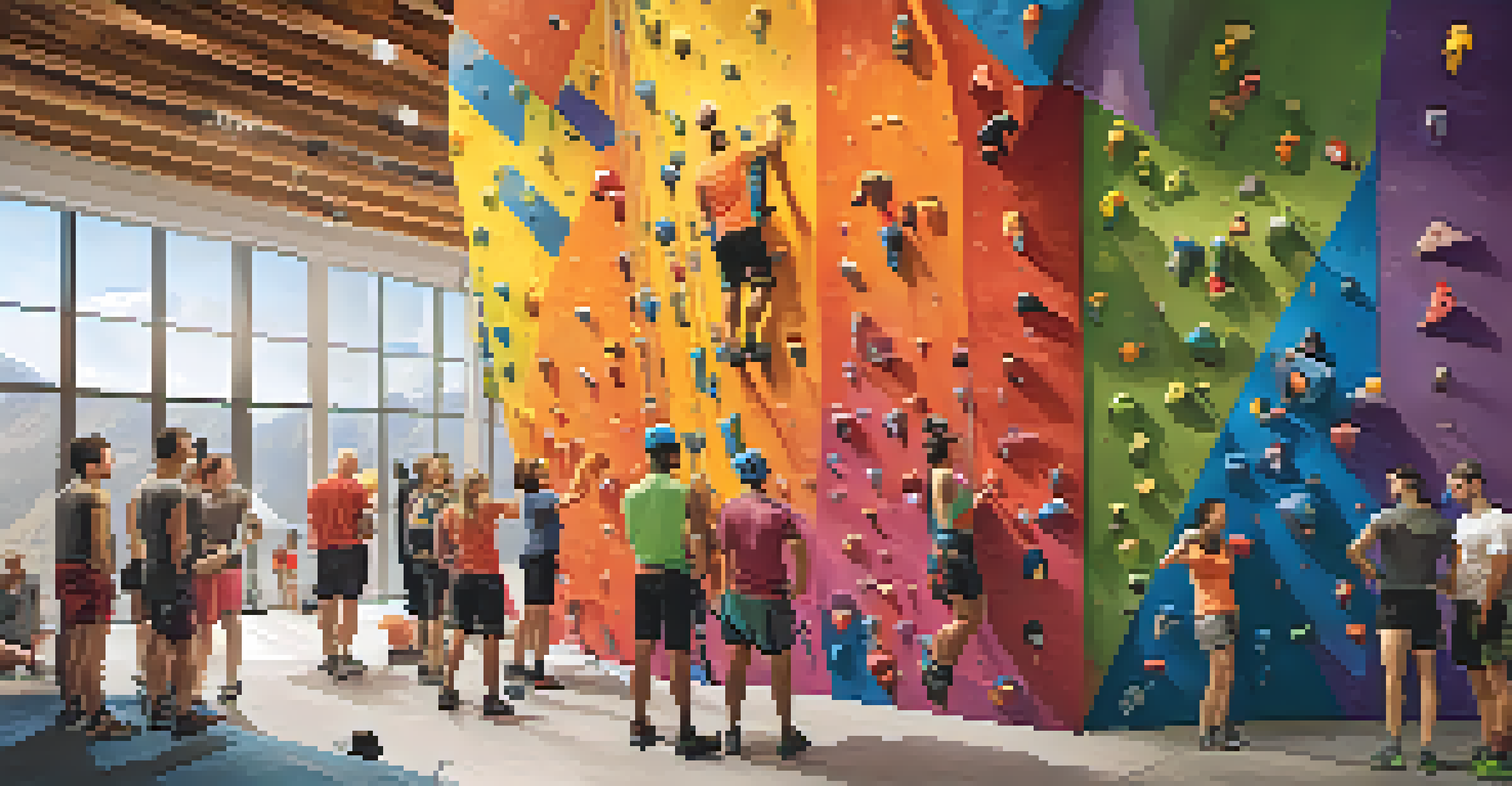Indoor Rock Climbing: Building Strength and Endurance Effectively

The Basics of Indoor Rock Climbing: What to Expect
Indoor rock climbing is an exhilarating activity that combines physical fitness with mental challenges. Whether you’re a beginner or a seasoned climber, you’ll find various routes tailored to your skill level. These climbing walls often simulate outdoor rock formations, giving you a taste of the real deal without leaving the gym.
Climbing is not just a sport; it's a way to connect with nature, challenge yourself, and find your limits.
One of the best parts is the supportive community you’ll encounter at climbing gyms. Everyone is there to learn and improve, fostering a welcoming atmosphere. You’ll likely find yourself cheering on fellow climbers, which can significantly enhance motivation and camaraderie.
As you step onto the climbing wall, keep in mind that it’s not just about brute strength. Technique, strategy, and body positioning play crucial roles in making your climb successful. This combination of skills will prepare you not only for indoor challenges but also for outdoor adventures.
Building Physical Strength: Key Muscles Engaged
Indoor rock climbing efficiently targets multiple muscle groups, making it an excellent full-body workout. Your arms, legs, back, and core all come into play as you navigate different routes. This engagement helps in building muscle strength and endurance, vital for both climbing and everyday activities.

The gripping and pulling actions work your biceps and forearms, while pushing off with your legs strengthens your quadriceps and calves. Additionally, your core muscles are constantly engaged to maintain balance and stability, which is essential for reaching higher holds.
Climbing A Builds Full-Body Strength
Indoor rock climbing engages multiple muscle groups, providing an effective full-body workout that enhances both strength and endurance.
As you push your limits on the wall, you’ll notice improvements in your overall physical strength over time. This strength not only benefits your climbing but also enhances your performance in other sports or physical tasks. Think of it as a multi-functional workout that keeps on giving.
Enhancing Endurance: Climbing as a Cardio Workout
While climbing may seem like a strength-focused activity, it also serves as an excellent cardiovascular workout. As you scale the wall, your heart rate increases, promoting better cardiovascular health. This boost in endurance is vital for tackling longer or more challenging climbs.
The best climber in the world is the one who has the most fun.
Many climbers find that their stamina improves rapidly once they start climbing regularly. You’ll often hear climbers compare their climbing sessions to a dance, where movement flows and energy is continuously expended. This rhythmic nature of climbing helps build endurance without the monotony of traditional cardio exercises.
Incorporating endurance training into your climbing routine can further enhance your performance. Consider adding longer climbing sessions or interval training, where you alternate between intense climbs and rest periods. This approach can help you push through fatigue and conquer more challenging routes.
Technique Matters: Climbing Smart for Strength Gains
Climbing is not just about how hard you can pull; it’s equally about how smart you climb. Good technique can help you conserve energy and maximize your strength output. Learning proper footwork, body positioning, and hand placements can dramatically improve your climbing efficiency.
For example, utilizing your legs more effectively can take the load off your arms, allowing you to climb longer without tiring. It’s like learning to dance—once you understand the movements, you can express yourself more freely and gracefully.
Technique Enhances Climbing Efficiency
Mastering proper climbing techniques can conserve energy and improve your overall climbing performance.
Don’t be afraid to seek advice from more experienced climbers or instructors. They can provide valuable insights into refining your technique, which can lead to significant strength and endurance improvements. Remember, practice makes perfect, and climbing is an art as much as it is a sport.
Injury Prevention: Staying Safe While Climbing
As with any physical activity, injury prevention is crucial in indoor rock climbing. Common injuries include strains, sprains, and overuse injuries, often resulting from improper technique or overtraining. Prioritizing safety will keep you climbing for the long haul.
Warming up before a climbing session is essential for preparing your muscles and joints. Incorporate dynamic stretches and mobility exercises to get your body ready for action. Additionally, listen to your body and avoid pushing yourself beyond your limits, especially when you're starting out.
Consider cross-training with activities like yoga or strength training to balance your climbing routine. These practices can enhance flexibility and build supporting muscle strength, helping to prevent injuries and improve overall performance. Safety should always be your top priority on and off the wall.
Setting Goals: Tracking Your Progress in Climbing
Setting goals in your climbing journey can keep you motivated and focused. Whether you aim to climb a specific route or improve your endurance, having clear objectives can guide your training. It’s important to track your progress to see how far you’ve come.
One effective way to track progress is through climbing logs or apps that allow you to log routes and workouts. Celebrate small victories, like completing a challenging route or improving your technique. These achievements can boost your confidence and encourage you to tackle even greater challenges.
Community Boosts Climbing Experience
The supportive climbing community fosters friendships and shared experiences, making the sport more enjoyable and motivating.
Don’t forget to adjust your goals as you progress. As you grow stronger and more skilled, your objectives should evolve to match your abilities. This mindset not only keeps climbing exciting but also ensures continuous improvement and personal growth.
Community and Support: The Social Side of Climbing
Indoor climbing isn’t just about personal achievement; it’s also about the community. Many climbers form friendships through shared experiences, making the sport more enjoyable. Climbing gyms often host events and competitions, fostering camaraderie among climbers.
Joining a climbing class or group can introduce you to fellow enthusiasts who share your passion. Training together not only enhances motivation but also allows for the exchange of tips and techniques. You’ll be surprised at how much more rewarding your climbing experience can be with a solid support system.

Engaging with the climbing community can also expose you to new challenges and opportunities. Whether it’s finding climbing partners for outdoor trips or learning about advanced techniques, the social aspect of climbing enriches your journey. Embrace the friendships you make along the way—they’re an integral part of the climbing experience.